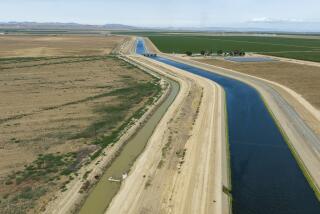
- Share via
- A federal order to increase U.S. timber production by 25% will touch all 18 of the Golden’s State’s national forests, officials said.
- The USDA said it does not yet have information about how many acres in each forest will be affected.
California’s national forests are on the chopping block — literally — in the wake of the Trump administration’s April 5 order to immediately expand timber production in the United States.
Last week, U.S. Secretary of Agriculture Brooke Rollins issued an emergency declaration that ordered the U.S. Forest Service to open up some 112.5 million acres of national forestland to logging.
The announcement included a grainy map of affected forests, which did not specify forest names or the amount of impacted acreage in each. However, U.S. Department of Agriculture officials have confirmed to The Times that the order will touch all 18 of the Golden State’s national forests, which collectively span more than 20 million acres.
“The USDA Forest Service stands ready to fulfill the Secretary’s vision of productive and resilient national forests outlined in the memorandum,” the agency said in a written statement. “In alignment with the Secretary’s direction, we will streamline forest management efforts, reduce burdensome regulations, and grow partnerships to support economic growth and sustainability.”
The Trump administration has rolled back environmental protections related to future logging projects in more than half of national forests under an emergency designation issued Friday that cites the dangers of wildfires.
California is home to more federal forests than any other state, including the Angeles, Sequoia and Klamath national forests. Officials with the USDA, which oversees the Forest Service, said they do not yet have information about how many acres in each forest will be affected.
The directive stems from President Trump’s recent executive order to expand American timber production by 25%, which Rollins argued in her notice will “better provide domestic timber supplies, create jobs and prosperity, reduce wildfire disasters, improve fish and wildlife habitats, and decrease costs of construction and energy.”
An internal memo from Chris French, acting associate chief of the Forest Service, directs the heads of all nine forest service regions to develop five-year strategies to increase their volume of timber, with the goal of an agency-wide increase of 25% over the next four to five years.
Environmental groups expressed outrage over the president’s order, which they said will circumvent legal protections, endangered species considerations, and public input in order to expedite logging and the removal of vegetation such as trees, plants and shrubs.
“This is a thinly veiled attempt to ramp up logging on our national forests, bypass environmental laws, and line the pockets of the timber industry,” wrote Jeff Kuyper, executive director of the nonprofit Los Padres ForestWatch, in an email. “This move — coupled with mass firings, budget cuts, and environmental rollbacks — will wreak havoc on the Los Padres and other national forests across the country.”
The Los Padres National Forest spans portions of Monterey, San Luis Obispo, Santa Barbara, Ventura, and Kern counties; Kuyper said that the Trump administration’s order appears to put at least 80% of the forest’s 1.75 million acres up for grabs.
‘These State laws and policies are fundamentally irreconcilable with my Administration’s objective to unleash American energy,’ the president wrote. ‘They should not stand.’
In his order, the president argued that “heavy-handed federal policies” from previous administrations have made the U.S. unnecessarily reliant on foreign timber producers. To that end, the order is in keeping with other recent moves by the administration to ease environmental regulations in exchange for lower consumer costs and greater independence from other countries.
But Trump also leaned on recent disasters as part of his justification, noting that “forest management and wildfire risk-reduction projects can save American lives and communities.”
Forest management is indeed a sore spot in California, where decades of fire suppression have allowed vegetation to build up, which is in turn acting as fuel for the state’s larger and more frequent blazes. However, experts have warned that clearing brush is not the same as large-scale logging or thinning, which some say can make the landscape more flammable. The subject is a matter of frequent debate.
The state’s forests in recent years have also suffered from extreme drought conditions, bark beetle infestations and other stressors that have contributed to increasing tree death.
What’s more, an influx of people moving into the wildland-urban interface — or the area where human development meets the natural landscape — is contributing to what Rollins described as a “full-blown wildfire and forest health crisis.”
“Healthy forests require work, and right now, we’re facing a national forest emergency,” Rollins wrote in a statement. “We have an abundance of timber at high risk of wildfires in our National Forests. I am proud to follow the bold leadership of President Trump by empowering forest managers to reduce constraints and minimize the risks of fire, insects, and disease so that we can strengthen American timber industry and further enrich our forests with the resources they need to thrive.”
The Forest Service manages 144 million forested acres across 43 states, of which approximately 43 million acres are suitable for timber production, Rollins said.
As the Palisades fire raged, critics blamed overgrown vegetation for driving its spread. But some scientists and fire officials say removing it may not have made much of a difference, and also risks making the landscape more flammable in the long run.
Though the federal order is not aimed at California specifically, it drives at the simmering tensions between the state and the president. During his first term in 2018, Trump blamed wildfires in California on the state government’s land management policies, and suggested that it should “rake” its forest floors.
He did not, however, acknowledge that 57% of the state’s 33 million acres of forest are controlled by the federal government.
In a statement, Randi Spivak, public lands director with the nonprofit Center for Biological Diversity, said the president’s order was akin to “feeding our national forests into the woodchipper.”
“Unleashing the bulldozers and chainsaws on these beautiful public lands will result in clearcuts, polluted streams and extinct species,” Spivak said. “More than 110 million acres of national forests fall under this dangerous edict. We will use every legal tool at our disposal to halt the Trump administration’s implementation of this order.”










